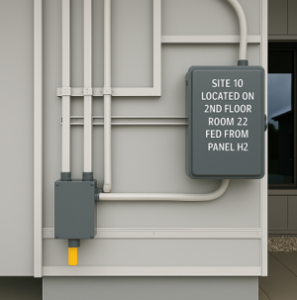How to Properly Identify Disconnecting Means in the 2023 NEC?
Overview
| The 2023 Florida Building Code (FBC) adopts the National Electrical Code (NEC) 110.22, which introduces a critical enhancement to the identification requirements for disconnecting means. Under the 2023 NEC, in other than one- or two-family dwellings, the marking on each disconnecting means must now include not only the identification of the circuit source that supplies it but also the location of that circuit source. |  |
This expands upon the 2020 NEC requirement, which mandated the identification of the circuit source but did not explicitly require its location. The fundamental principle remains that each disconnecting means must be legibly marked to indicate its purpose, unless its purpose is self-evident due to its location and arrangement. The marking must also be sufficiently durable to withstand the environment. This change is a direct measure to enhance safety, particularly for service electricians and building owners, by ensuring that the source of a circuit can be quickly and easily identified and located in the event of an emergency or for maintenance.
For highly skilled electricians, this revision necessitates a more meticulous approach to labeling and documentation in commercial and multi-family installations. It is no longer sufficient to simply label a disconnect with “Panel H-1”; the label must now specify where Panel H-1 is located (e.g., “Panel H-1, 3rd Floor Electrical Room”) if its location is not immediately obvious. This requirement aims to prevent delays and potential hazards during troubleshooting, maintenance, or emergency shutdown procedures. Electricians are now responsible for ensuring that all new and modified disconnecting means comply with this enhanced labeling standard, which may involve updating existing labeling practices and utilizing durable, clearly visible labels. The emphasis on both identification and location underscores a broader commitment to improving electrical safety and operational efficiency in complex building environments, reducing the risk of accidental energization or prolonged power outages during critical events.
